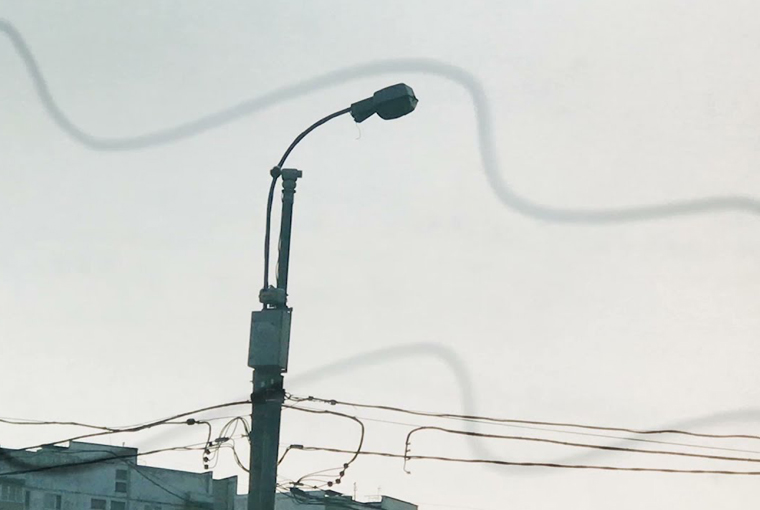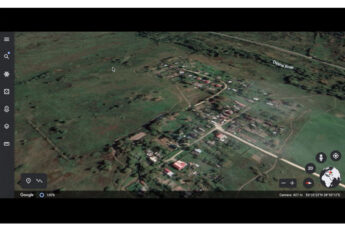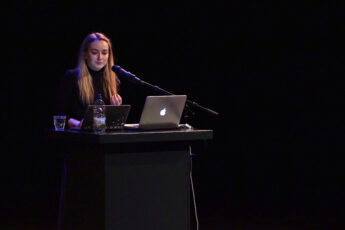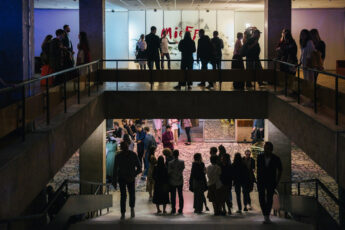Intertwining of Mediums
Elina Bolshenkova, Rupert Clervaux and Stas Sharifullin’s Revolution 0 (2021) & Katerina Bychkova and Taya Galkova’s Katya (2021)
Vol. 120 (December 2021) by Anna Doyle
Since its very beginnings, cinema has been thought of as a derivative art form that borrows from other media: theater, literature, music, or painting. In recent experimentations in cinema, a novel combination between poetic texts and experimental electronic music has brought both mediums closer to each other, allowing spectators to cross the boundaries between the two. This interlacing of different media formats can be seen in two films that screened at the 2021 Moscow International Experimental film festival, Revolution 0 and Katya. Both projects departed from music and poems written together specifically for these films. Taya Galkova composed a text and musical score for Katya, while Rupert Clervaux and Stas Sharifullin devised a poem and a musical score respectively for Revolution 0. Both films then became music videos.
Each medium has its specificity and power, and both gain further dimensions from interacting with the other. Music put to a film is not simply a way of producing a “soundtrack” for it; writing a poem for a piece of music goes beyond writing lyrics for it. And transposing both music and poetry to images, each transmitting a particular emotion, can reveal the varying expressive potential of experimental cinema whereby the initial poetic text can acquire new meaning when linked with images. Whereas Katya is a film about survival and a homage to grandmothers attended by an arresting piece of electronic music, Revolution 0 is a meditation on immateriality.
Reverting to Super 8-cameras and found-footage, which is freely associated during editing, both films convey a sense of the world as poised between passing and survival. This dialectic between passing and survival is not so much meant in an ecological or political sense, but in that they are the modes through which humans perceive and experience everyday life as they struggle to find their bearings. The fragility and deceptiveness of perception and memory are conveyed by the changing textures of images, which switch from found footage to diary images or from animation to abstractness, and by the changing quality of sounds, which work with electronic repetitions, refrains, and voice-overs.
In Revolution 0, we hear a poem being read by Rupert Clervaux in English to images of veils moving and to fragments of unidentifiable objects in the city which keep appearing and disappearing. The film defies the prisms of language and image, opening itself up to multiple interpretations and meanings, not least by resorting to resounding echoes. The openness to interpretation is also conveyed by eerie and minimalist music and ghostly images. The poem, meanwhile, speaks of the “solipsistic” experience of “self-erasure” that becomes a “consensus”. In other words, it fulfills a movement of overcoming solipsistic subjectivity and its protective solitude to reach out to the exterior world. Its voice is that of a fictional character – a person in hiding, being looked for, under surveillance and injured in the aftermath of an undisclosed event – but this is never shown or explicitly demonstrated in the film. The voice erases itself progressively until there is no word left, the very last seconds of the film letting the spectator listen to music and contemplate images.
In Revolution 0, music, film, and poetry intertwine to create a borderline perception between recognition and non-recognition. “Beware now of darkness spoken through a city veiled in colluding eyes”, the voice-over tells us to images of abstract traffic lights in a city. Clouds and veiled apparitions take shape, as if misguiding the spectator’s eye. “In dreams of familiar voices, we look for an echo of unfamiliar resemblance”, the voice now tells us as an apparition fades into the walls. Perhaps, the image suggests, the voice is that of the ghost of a woman? In an interview, Rupert Clervaux tells us it is Emma Goldman’s voice, the Russian anarchist feminist of the early 20th century who has been a source of inspiration for Clervaux. The music seems to mimic this dialectic between mystery and guessing. Words are whispered to convey the sense of an enigmatic magic spell, evoking what is seen on screen, the disappearance of figures, and of bodies that evaporate. The symphonic juxtaposition of electronic music and poetry to images allows a transformation of perception and of temporalities. Time in Revolution 0, as the title states, is mobile but at the same time stuck in a realm of atemporality, where fears of the future or hope for patency are juxtaposed.
In Katya, the music by Taya Galkova does not only accompany the words she has written as well as the images by Katerina Bychkova. It almost seems to breathe life into them. Meanwhile, images of trains and found-footage travel diaries are a visual backdrop for much of the film. The train is also the place where the words for the film were actually written. The format of the image in small squares, arranged like a postcard, emphasizes the travel dimension. However, if the images do bring an interesting travel dimension to the story, the found-footage images are from an American source and unfortunately seem out of sync with the poem at certain places.
Katya is also an Ode to grandmothers and maternal love. In Russia as elsewhere in the former Soviet Union, grandmothers play an essential role in the upbringing and care of children – many grandmothers look after children, partly because fathers tend to avoid this responsibility. In the film, women survive the elementary troubles of life: sickness (diphtheria, strokes), war, bearing children etc. However, their strength resides in caring, and in the elementary tactics of resistance, which are quite simply the everyday pleasures of life: singing, laughing, talking, feeding. The film is infused with the ethics of a philosophy of care as defined by Eric Gagnon: “Care refers to all the essential gestures and words aimed at maintaining the life and dignity of people, well beyond health services alone. It refers as much to individuals’ disposition – solicitude, attention to others – as to care activities – washing, dressing, comforting, etc. – taking into account both the person who helps and the person who is helped as well as the social and economic context in which this relationship takes place.”1 Contemporary philosophers understand care as a new moral value that goes beyond classical definitions of morality, often understanding it as a specifically feminine trait: according to feminist Carol Gilligan (In a Different Voice), women are much more invested in caring relationships that tie them to others than men, who are traditionally viewed as being more individualistic and more competitive and thus socialized accordingly.
Of course, this elementary way of life based on caring and struggling for survival is relevant to Soviet history, notably the hardships endured during the war. But this elementary philosophy of life also applies to filmmaking in that the found-footage images are often abstract and rudimentary. Telling sweet anecdotes – notably that of a cow coming to visit the grandmother in the hospital, which is a tale recounted in Katya’s libretto – is also a way of demonstrating how a simple event – a cow caring for a grandmother – can make us believe in the magic of life in the most difficult moments. Thus, Katya allows the spectator to acknowledge the power of women in their fight for life. The film’s musical, poetic and visual rhythm becomes the soundtrack to the struggles, hopes and – ultimately – victories of a woman’s life.
Katya and Revolution 0 use poetry in novel ways. They do not focus on an exploration of the self, as confessional poetry does, but resort to poetry as a way of overcoming the self and opening oneself to others and to the world that surrounds us. This is allowed by experimental imagery and electronic rhythms that open up the poetic text to a representation of a deceptive perception and of life’s victory over death. Despite their murky atmosphere, Revolution 0 and Katya thus convey a sense of hope and catharsis. By transgressing the boundaries of the video-clip, the filmmakers allow the viewer to embrace a gratifying experience of visual, musical, and textual interconnection. And that interdependency of each medium is a way of healing the spectator’s own troubles, whether they relate to her identity or to existential woes. Both films picture a way out of the protected solipsism of poetry, thereby helping us to recognize the world that surrounds us and to care for the ones we cherish despite our struggles.
References
- 1.Eric Gagnon. Care. In: Anthropen.org, Paris, Éditions des archives contemporaines, 2016.




Leave a Comment